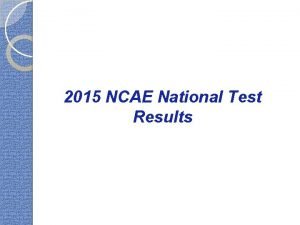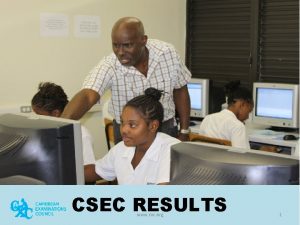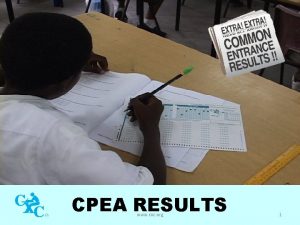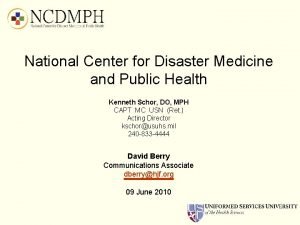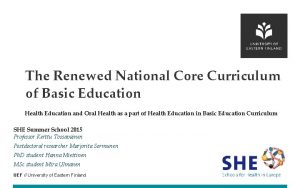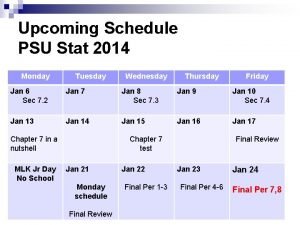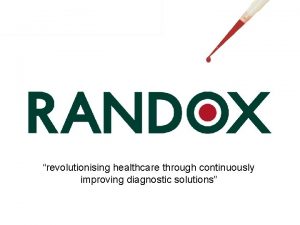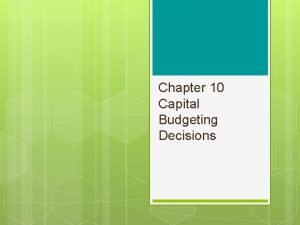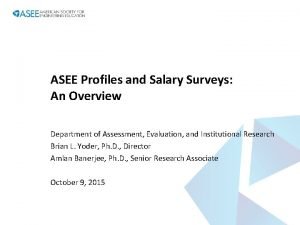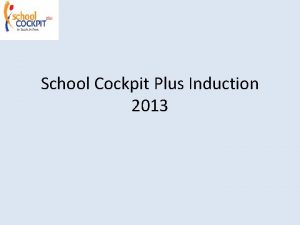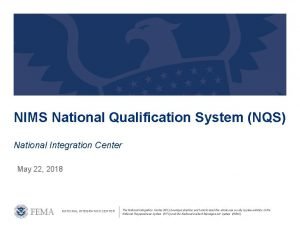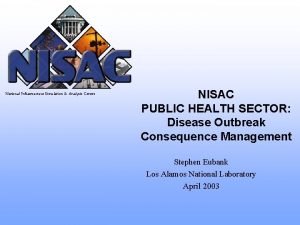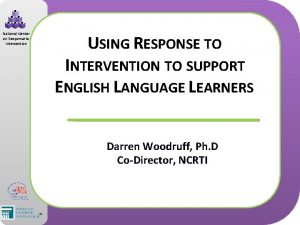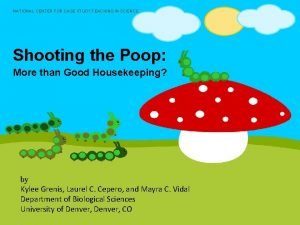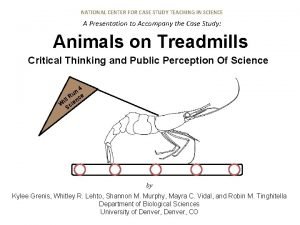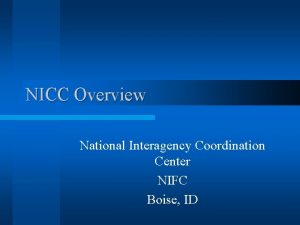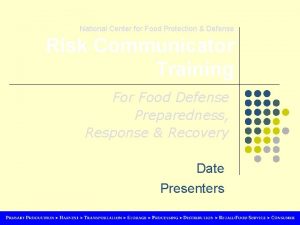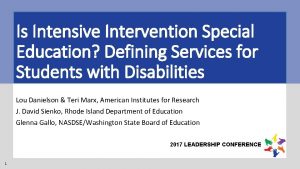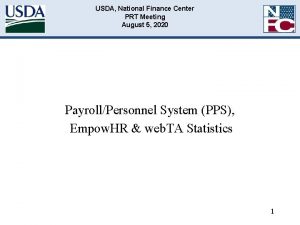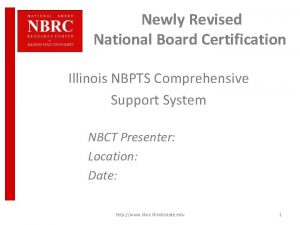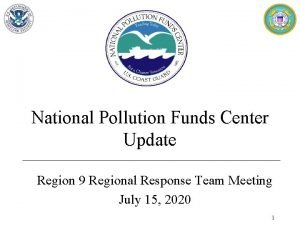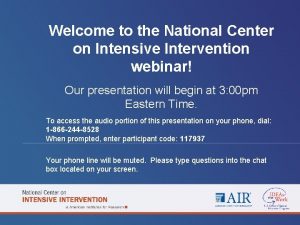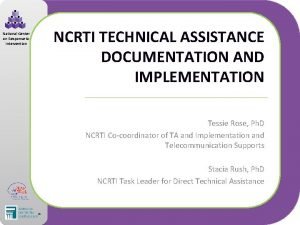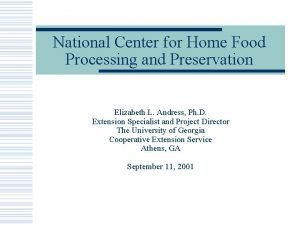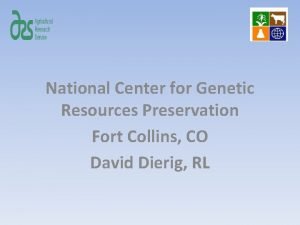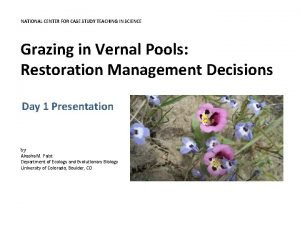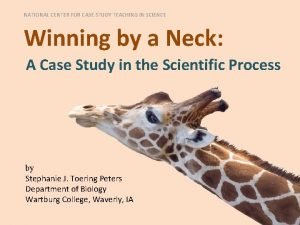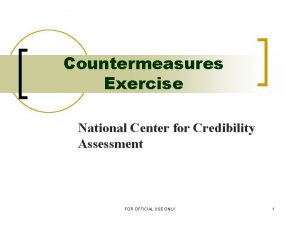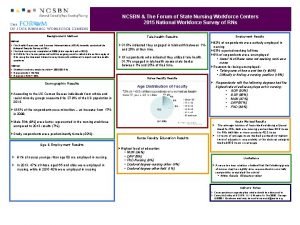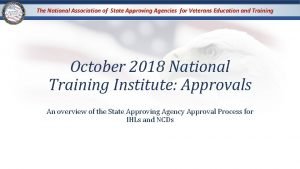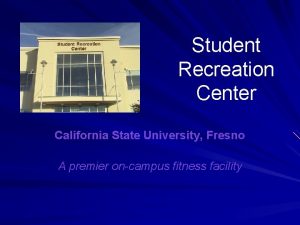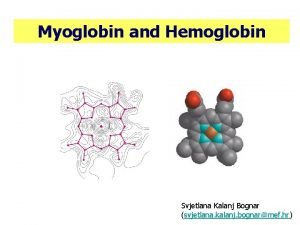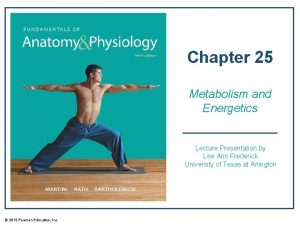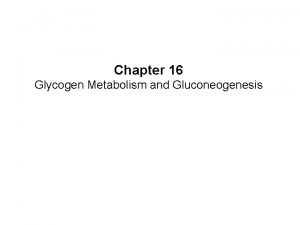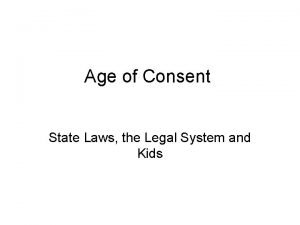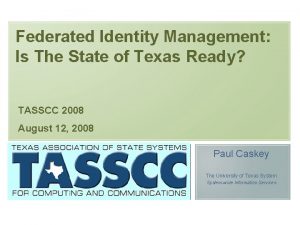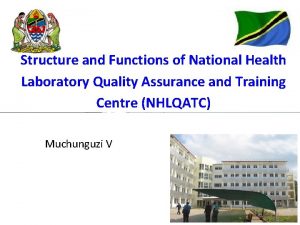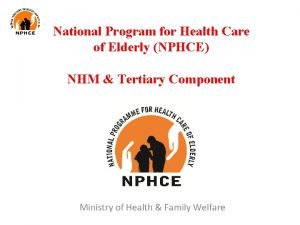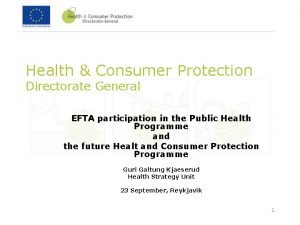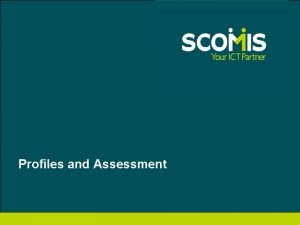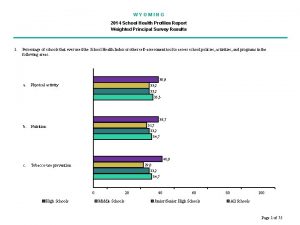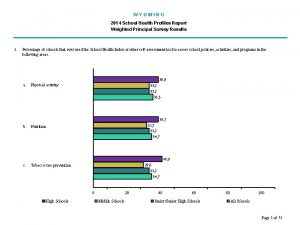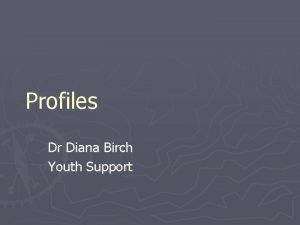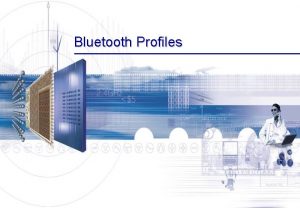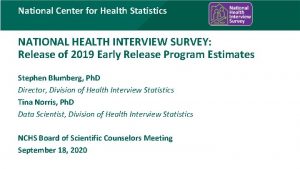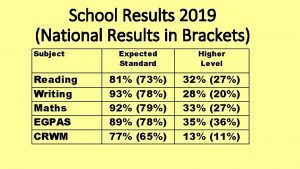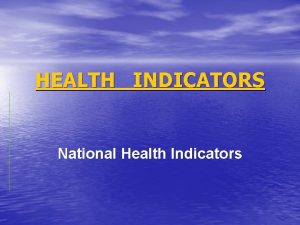School Health Profiles 2014 State Results National Center




































































































































- Slides: 132

School Health Profiles 2014 State Results National Center for HIV/AIDS, Viral Hepatitis, STD, and TB Prevention Division of Adolescent and School Health

What is the School Health Profiles (Profiles)? • • • Profiles is a system of surveys assessing school health policies and practices in states, territories, and large urban school districts Profiles surveys are conducted biennially (during even-numbered years) by state, territorial, and local education and health agencies with technical assistance from CDC Profiles questionnaires are administered to middle and high school principals and lead health education teachers

Topics Monitored by Profiles • • School health education requirements and content Physical education and physical activity Practices related to bullying and sexual harassment School health policies related to tobacco-use prevention and nutrition School-based health services Family engagement and community involvement School health coordination

Profiles Participation, 1998 – 2014 1998 2000 2002 2004 2006 2008 2010 2012 2014 # of states 38 38 43 41 44 50 50 49 50 # of large urban school districts 10 13 14 13 16 21 20 19 21 # of territories -- -- -- 5 6 5 3 # of tribal governments -- -- -- 2 2 2 -- Total # of sites 48 51 57 54 60 78 78 75 74 Total % of sites with weighted data 77% 75% 77% 70% 82% 94% 99% 92% 96%

State and District Participation, Profiles 2014 9/6/2021

Uses of Profiles Data Education and health officials use Profiles data to • Describe school health policies and practices and compare them across jurisdictions • Identify professional development needs • Plan and monitor programs • Support health-related policies and legislation • Seek funding • Garner support for future surveys

Examples of Uses of Profiles Data • Montana § Used Profiles results to develop customized technical assistance plans for selected schools to increase attention towards nutrition physical activity, and employee wellness • Florida § Used Profiles results to develop the agenda for their Healthy Schools Summer Academy professional development event • Alaska § Use Profiles data to help write a grant to support rural school health services

Profiles Information http: //www. cdc. gov/schoolhealthprofiles § § § § Overview of the School Health Profiles Questionnaires and item rationales Comprehensive results Fact sheet Publications and journal articles Participation history Frequently asked questions about requesting data files Data file request form

HIV, STD, and Pregnancy Prevention

Percentage of secondary schools that taught 11 key HIV, STD, and pregnancy prevention topics in a required course during grades 6, 7, or 8 and during grades 9, 10, 11, or 12 0% - 24% 25% - 49% 50% - 74% 75% - 100% No Data School Health Profiles, 2014

Percentage of secondary schools that assessed the ability of students to do 7 skills in a required course during grades 6, 7, or 8 and during grades 9, 10, 11, or 12 0% - 24% 25% - 49% 50% - 74% 75% - 100% No Data School Health Profiles, 2014

Percentage of secondary schools in which those who teach sexual health education are provided with key materials for teaching sexual health education 0% - 24% 25% - 49% 50% - 74% 75% - 100% No Data School Health Profiles, 2014

Percentage of secondary schools in which the lead health education teacher received professional development during the 2 years before the survey on 10 key HIV prevention topics 0% - 24% 25% - 49% 50% - 74% 75% - 100% No Data School Health Profiles, 2014

Percentage of secondary schools that taught about 7 contraceptives in a required course during grades 9, 10, 11, or 12 0% - 24% 25% - 49% 50% - 74% 75% - 100% No Data School Health Profiles, 2014

Percentage of secondary schools that tried to increase student knowledge on HIV prevention in a required course 0% - 24% 25% - 49% 50% - 74% 75% - 100% No Data School Health Profiles, 2014

Percentage of secondary schools that tried to increase student knowledge on human sexuality in a required course 0% - 24% 25% - 49% 50% - 74% 75% - 100% No Data School Health Profiles, 2014

Percentage of secondary schools that tried to increase student knowledge on pregnancy prevention in a required course 0% - 24% 25% - 49% 50% - 74% 75% - 100% No Data School Health Profiles, 2014

Percentage of secondary schools that tried to increase student knowledge on STD prevention in a required course 0% - 24% 25% - 49% 50% - 74% 75% - 100% No Data School Health Profiles, 2014

Percentage of secondary schools that taught how HIV and other STDs are transmitted in a required course 0% - 24% 25% - 49% 50% - 74% 75% - 100% No Data School Health Profiles, 2014

Percentage of secondary schools that taught health consequences of HIV, other STDs, and pregnancy in a required course 0% - 24% 25% - 49% 50% - 74% 75% - 100% No Data School Health Profiles, 2014

Percentage of secondary schools that taught the benefits of being sexually abstinent in a required course 0% - 24% 25% - 49% 50% - 74% 75% - 100% No Data School Health Profiles, 2014

Percentage of secondary schools that taught how to access valid and reliable health information, products, or services related to HIV, other STDs, and pregnancy in a required course 0% - 24% 25% - 49% 50% - 74% 75% - 100% No Data School Health Profiles, 2014

Percentage of secondary schools that taught the influences of family, peers, media, technology, and other factors on sexual risk behaviors in a required course 0% - 24% 25% - 49% 50% - 74% 75% - 100% No Data School Health Profiles, 2014

Percentage of secondary schools that taught communication and negotiation skills related to eliminating or reducing risk for HIV, other STDs, and pregnancy in a required course 0% - 24% 25% - 49% 50% - 74% 75% - 100% No Data School Health Profiles, 2014

Percentage of secondary schools that taught goal-setting and decision-making skills related to eliminating or reducing risk for HIV, other STDs, and pregnancy in a required course 0% - 24% 25% - 49% 50% - 74% 75% - 100% No Data School Health Profiles, 2014

Percentage of secondary schools that taught influencing and supporting others to avoid or reduce sexual risk behaviors in a required course 0% - 24% 25% - 49% 50% - 74% 75% - 100% No Data School Health Profiles, 2014

Percentage of secondary schools that taught efficacy of condoms in a required course 0% - 24% 25% - 49% 50% - 74% 75% - 100% No Data School Health Profiles, 2014

Percentage of secondary schools that taught the importance of using condoms consistently and correctly in a required course 0% - 24% 25% - 49% 50% - 74% 75% - 100% No Data School Health Profiles, 2014

Percentage of secondary schools that taught how to obtain condoms in a required course 0% - 24% 25% - 49% 50% - 74% 75% - 100% No Data School Health Profiles, 2014

Percentage of secondary schools that taught how to correctly use a condom in a required course 0% - 24% 25% - 49% 50% - 74% 75% - 100% No Data School Health Profiles, 2014

Percentage of secondary schools that taught the importance of using a condom at the same time as another form of contraception to prevent both STDs and pregnancy in a required course 0% - 24% 25% - 49% 50% - 74% 75% - 100% No Data School Health Profiles, 2014

Percentage of secondary schools that taught how to create and sustain healthy and respectful relationships in a required course 0% - 24% 25% - 49% 50% - 74% 75% - 100% No Data School Health Profiles, 2014

Percentage of secondary schools that taught the importance of limiting the number of sexual partners in a required course 0% - 24% 25% - 49% 50% - 74% 75% - 100% No Data School Health Profiles, 2014

Percentage of secondary schools that taught preventive care that is necessary to maintain reproductive and sexual health in a required course 0% - 24% 25% - 49% 50% - 74% 75% - 100% No Data School Health Profiles, 2014

Percentage of secondary schools with a policy on students or staff who have HIV infection or AIDS that addresses attendance of students with HIV infection, procedures to protect HIV-infected students and staff from discrimination, and maintaining confidentiality of HIV-infected students and staff 0% - 24% 25% - 49% 50% - 74% 75% - 100% No Data School Health Profiles, 2014

Percentage of secondary schools in which the lead health education teacher received professional development during the 2 years before the survey on HIV prevention 0% - 24% 25% - 49% 50% - 74% 75% - 100% No Data School Health Profiles, 2014

Percentage of secondary schools in which the lead health education teacher received professional development during the 2 years before the survey on human sexuality 0% - 24% 25% - 49% 50% - 74% 75% - 100% No Data School Health Profiles, 2014

Percentage of secondary schools in which the lead health education teacher received professional development during the 2 years before the survey on pregnancy prevention 0% - 24% 25% - 49% 50% - 74% 75% - 100% No Data School Health Profiles, 2014

Percentage of secondary schools in which the lead health education teacher received professional development during the 2 years before the survey on STD prevention 0% - 24% 25% - 49% 50% - 74% 75% - 100% No Data School Health Profiles, 2014

Practices Related to Safe and Supportive Environments

Percentage of secondary schools that provide curricula or supplementary materials that include HIV, STD, or pregnancy prevention information that is relevant to LGBTQ youth 0% - 24% 25% - 49% 50% - 74% 75% - 100% No Data School Health Profiles, 2014

Percentage of secondary schools in which the lead health education teacher received professional development during the 2 years before the survey on teaching students of different sexual orientations or gender identities 0% - 24% 25% - 49% 50% - 74% 75% - 100% No Data School Health Profiles, 2014

Percentage of secondary schools with a gay/straight alliance or similar club 0% - 24% 25% - 49% 50% - 74% 75% - 100% No Data School Health Profiles, 2014

Percentage of secondary schools that implement parent engagement strategies for all students 0% - 24% 25% - 49% 50% - 74% 75% - 100% No Data School Health Profiles, 2014

Percentage of secondary schools that implement school connectedness strategies 0% - 24% 25% - 49% 50% - 74% 75% - 100% No Data School Health Profiles, 2014

Percentage of secondary schools that prevent bullying and sexual harassment, including electronic aggression, among all students 0% - 24% 25% - 49% 50% - 74% 75% - 100% No Data School Health Profiles, 2014

Percentage of secondary schools that provide curricula or supplementary materials and engage in 5 practices related to LGBTQ youth 0% - 24% 25% - 49% 50% - 74% 75% - 100% No Data School Health Profiles, 2014

Percentage of secondary schools that identify “safe spaces” where LGBTQ youth can receive support from administrators, teachers, or other school staff 0% - 24% 25% - 49% 50% - 74% 75% - 100% No Data School Health Profiles, 2014

Percentage of secondary schools that prohibit harassment based on a student’s perceived or actual sexual orientation or gender identity 0% - 24% 25% - 49% 50% - 74% 75% - 100% No Data School Health Profiles, 2014

Percentage of secondary schools that encourage staff to attend professional development on safe and supportive school environments for all students, regardless of sexual orientation or gender identity 0% - 24% 25% - 49% 50% - 74% 75% - 100% No Data School Health Profiles, 2014

Percentage of secondary schools that facilitate access to providers not on school property who have experience in providing health services to LGBTQ youth 0% - 24% 25% - 49% 50% - 74% 75% - 100% No Data School Health Profiles, 2014

Percentage of secondary schools that facilitate access to providers not on school property who have experience in providing social and psychological services to LGBTQ youth 0% - 24% 25% - 49% 50% - 74% 75% - 100% No Data School Health Profiles, 2014

School Health Services

Percentage of secondary schools that provide students with on-site services or referrals to healthcare providers for 7 sexual health services 0% - 24% 25% - 49% 50% - 74% 75% - 100% No Data School Health Profiles, 2014

Percentage of secondary schools that provide HIV testing to students 0% - 24% 25% - 49% 50% - 74% 75% - 100% No Data School Health Profiles, 2014

Percentage of secondary schools that provide HIV treatment to students 0% - 24% 25% - 49% 50% - 74% 75% - 100% No Data School Health Profiles, 2014

Percentage of secondary schools that provide STD testing to students 0% - 24% 25% - 49% 50% - 74% 75% - 100% No Data School Health Profiles, 2014

Percentage of secondary schools that provide STD treatment to students 0% - 24% 25% - 49% 50% - 74% 75% - 100% No Data School Health Profiles, 2014

Percentage of secondary schools that provide pregnancy testing to students 0% - 24% 25% - 49% 50% - 74% 75% - 100% No Data School Health Profiles, 2014

Percentage of secondary schools that provide condoms to students 0% - 24% 25% - 49% 50% - 74% 75% - 100% No Data School Health Profiles, 2014

Percentage of secondary schools that provide condom-compatible lubricants to students 0% - 24% 25% - 49% 50% - 74% 75% - 100% No Data School Health Profiles, 2014

Percentage of secondary schools that provide contraceptives other than condoms to students 0% - 24% 25% - 49% 50% - 74% 75% - 100% No Data School Health Profiles, 2014

Percentage of secondary schools that provide prenatal care to students 0% - 24% 25% - 49% 50% - 74% 75% - 100% No Data School Health Profiles, 2014

Percentage of secondary schools that provide HPV vaccine administration to students 0% - 24% 25% - 49% 50% - 74% 75% - 100% No Data School Health Profiles, 2014

Percentage of secondary schools that provide students with referrals* for HIV testing 0% - 24% 25% - 49% 50% - 74% 75% - 100% No Data *To any organizations or health care professionals not on school property. School Health Profiles, 2014

Percentage of secondary schools that provide students with referrals* for HIV treatment 0% - 24% 25% - 49% 50% - 74% 75% - 100% No Data *To any organizations or health care professionals not on school property. School Health Profiles, 2014

Percentage of secondary schools that provide students with referrals* for STD testing 0% - 24% 25% - 49% 50% - 74% 75% - 100% No Data *To any organizations or health care professionals not on school property. School Health Profiles, 2014

Percentage of secondary schools that provide students with referrals* for STD treatment 0% - 24% 25% - 49% 50% - 74% 75% - 100% No Data *To any organizations or health care professionals not on school property. School Health Profiles, 2014

Percentage of secondary schools that provide students with referrals* for pregnancy testing 0% - 24% 25% - 49% 50% - 74% 75% - 100% No Data *To any organizations or health care professionals not on school property. School Health Profiles, 2014

Percentage of secondary schools that provide students with referrals* for condoms 0% - 24% 25% - 49% 50% - 74% 75% - 100% No Data *To any organizations or health care professionals not on school property. School Health Profiles, 2014

Percentage of secondary schools that provide students with referrals* for condom -compatible lubricants 0% - 24% 25% - 49% 50% - 74% 75% - 100% No Data *To any organizations or health care professionals not on school property. School Health Profiles, 2014

Percentage of secondary schools that provide students with referrals* for contraceptives other than condoms 0% - 24% 25% - 49% 50% - 74% 75% - 100% No Data *To any organizations or health care professionals not on school property. School Health Profiles, 2014

Percentage of secondary schools that provide students with referrals* for prenatal care 0% - 24% 25% - 49% 50% - 74% 75% - 100% No Data *To any organizations or health care professionals not on school property. School Health Profiles, 2014

Percentage of secondary schools that provide students with referrals* for HPV vaccine administration 0% - 24% 25% - 49% 50% - 74% 75% - 100% No Data *To any organizations or health care professionals not on school property. School Health Profiles, 2014

Percentage of secondary schools that identify and track students with chronic conditions* that may require daily or emergency management 0% - 24% 25% - 49% 50% - 74% 75% - 100% No Data *For example, asthma or food allergies. School Health Profiles, 2014

Percentage of secondary schools that have protocols that ensure students with a chronic condition that may require daily or emergency management are enrolled into private, state, or federally funded insurance programs if eligible 0% - 24% 25% - 49% 50% - 74% 75% - 100% No Data School Health Profiles, 2014

Percentage of secondary schools that provide referrals to community-based medical care providers for students identified with chronic conditions or at risk for activity, diet, and weight-related chronic conditions 0% - 24% 25% - 49% 50% - 74% 75% - 100% No Data School Health Profiles, 2014

School Health Coordination

Percentage of secondary schools that had a school health council, committee, or team that offers guidance on the development of policies or coordinates activities on health topics 0% - 24% 25% - 49% 50% - 74% 75% - 100% No Data School Health Profiles, 2014

Percentage of secondary schools that have a school health council, committee, or team with representation from at least 6 of 8 groups 0% - 24% 25% - 49% 50% - 74% 75% - 100% No Data School Health Profiles, 2014

Percentage of secondary schools that used the School Health Index or other selfassessment tool to assess their policies, activities, and programs in HIV, STD, and teen pregnancy prevention; physical activity; nutrition; and tobacco-use prevention 0% - 24% 25% - 49% 50% - 74% 75% - 100% No Data School Health Profiles, 2014

Percentage of secondary schools that include at least 1 health and safety objective in their school improvement plan and have completed a self-assessment of school health policies and practices and have reviewed health and safety data during the past year as part of their school improvement planning process 0% - 24% 25% - 49% 50% - 74% 75% - 100% No Data School Health Profiles, 2014

Percentage of secondary schools that have a school health team that performs 5 actions to help plan and implement school health programs 0% - 24% 25% - 49% 50% - 74% 75% - 100% No Data School Health Profiles, 2014

Health Education

Percentage of secondary schools with a health education curriculum that addresses all 8 national standards for health education 0% - 24% 25% - 49% 50% - 74% 75% - 100% No Data School Health Profiles, 2014

Percentage of secondary schools that required students to take 2 or more health education courses 0% - 24% 25% - 49% 50% - 74% 75% - 100% No Data School Health Profiles, 2014

Among secondary schools that required a health education course, percentage that required students who fail the course to repeat it 0% - 24% 25% - 49% 50% - 74% 75% - 100% No Data School Health Profiles, 2014

Percentage of secondary schools in which the lead health education teacher had professional preparation in health education or in health and physical education combined 0% - 24% 25% - 49% 50% - 74% 75% - 100% No Data School Health Profiles, 2014

Tobacco-Use Prevention

Percentage of secondary schools that prohibited all tobacco use at all times in all locations* 0% - 24% 25% - 49% 50% - 74% 75% - 100% No Data *Prohibited the use of all tobacco, including cigarettes, smokeless tobacco, cigars, and pipes, by students, faculty and school staff, and visitors, in school buildings, outside on school grounds, on school buses or other vehicles used to transport students, and at off-campus, school-sponsored events, during school hours and non-school hours. School Health Profiles, 2014

Percentage of secondary schools that taught 18 key tobacco-use prevention topics in a required course 0% - 24% 25% - 49% 50% - 74% 75% - 100% No Data School Health Profiles, 2014

Percentage of secondary schools that provided tobacco cessation services for students, faculty, and staff at school or through arrangements with providers not on school property 0% - 24% 25% - 49% 50% - 74% 75% - 100% No Data School Health Profiles, 2014

Percentage of secondary schools in which the lead health education teacher received professional development during the 2 years before the survey on tobacco-use prevention 0% - 24% 25% - 49% 50% - 74% 75% - 100% No Data School Health Profiles, 2014

Percentage of secondary schools that posted signs marking a tobacco-free school zone 0% - 24% 25% - 49% 50% - 74% 75% - 100% No Data School Health Profiles, 2014

Nutrition

Percentage of secondary schools that did not sell less healthy foods and beverages* in vending machines or at the school store, canteen, or snack bar 0% - 24% 25% - 49% 50% - 74% 75% - 100% No Data *Baked goods not low in fat, salty snacks not low in fat, chocolate candy, other kinds of candy, soda pop or fruit drinks that are not 100% juice, and sports drinks. School Health Profiles, 2014

Percentage of secondary schools in which students could not purchase chocolate candy from vending machines or at the school store, canteen, or snack bar 0% - 24% 25% - 49% 50% - 74% 75% - 100% No Data School Health Profiles, 2014

Percentage of secondary schools in which students could not purchase other kinds of candy from vending machines or at the school store, canteen, or snack bar 0% - 24% 25% - 49% 50% - 74% 75% - 100% No Data School Health Profiles, 2014

Percentage of secondary schools in which students could not purchase salty snacks that are not low in fat* from vending machines or at the school store, canteen, or snack bar 0% - 24% 25% - 49% 50% - 74% 75% - 100% No Data *Such as regular potato chips. School Health Profiles, 2014

Percentage of secondary schools in which students could not purchase cookies, crackers, cakes, pastries, or other baked goods that are not low in fat from vending machines or at the school store, canteen, or snack bar 0% - 24% 25% - 49% 50% - 74% 75% - 100% No Data School Health Profiles, 2014

Percentage of secondary schools in which students could not purchase 2% or whole milk from vending machines or at the school store, canteen, or snack bar 0% - 24% 25% - 49% 50% - 74% 75% - 100% No Data School Health Profiles, 2014

Percentage of secondary schools in which students could not purchase soda pop or fruit drinks that are not 100% juice from vending machines or at the school store, canteen, or snack bar 0% - 24% 25% - 49% 50% - 74% 75% - 100% No Data School Health Profiles, 2014

Percentage of secondary schools in which students could not purchase sports drinks* from vending machines or at the school store, canteen, or snack bar 0% - 24% 25% - 49% 50% - 74% 75% - 100% No Data *Such as Gatorade. School Health Profiles, 2014

Percentage of secondary schools in which students could not purchase energy drinks* from vending machines or at the school store, canteen, or snack bar 0% - 24% 25% - 49% 50% - 74% 75% - 100% No Data *Such as Red Bull or Monster. School Health Profiles, 2014

Percentage of secondary schools in which students could not purchase foods or beverages containing caffeine from vending machines or at the school store, canteen, or snack bar 0% - 24% 25% - 49% 50% - 74% 75% - 100% No Data School Health Profiles, 2014

Percentage of secondary schools that allowed students to purchase fruits and vegetables from vending machines or at the school store, canteen, or snack bar 0% - 24% 25% - 49% 50% - 74% 75% - 100% No Data School Health Profiles, 2014

Percentage of secondary schools that prohibited all forms of advertising and promotion of candy, fast food restaurants, or soft drinks in all locations* 0% - 24% 25% - 49% 50% - 74% 75% - 100% No Data *In school buildings; on school grounds, including on the outside of the school building, on playing fields, or other areas of the campus; on school buses or other vehicles used to transport students; and in school publications. School Health Profiles, 2014

Percentage of secondary schools that priced nutritious foods and beverages at a lower cost while increasing the price of less nutritious foods and beverages 0% - 24% 25% - 49% 50% - 74% 75% - 100% No Data School Health Profiles, 2014

Percentage of secondary schools that provided information to students or families on the nutrition and caloric content of foods available 0% - 24% 25% - 49% 50% - 74% 75% - 100% No Data School Health Profiles, 2014

Percentage of secondary schools that placed fruits and vegetables near the cafeteria cashier, where they are easy to access 0% - 24% 25% - 49% 50% - 74% 75% - 100% No Data School Health Profiles, 2014

Percentage of secondary schools that allowed students to have access to drinking water 0% - 24% 25% - 49% 50% - 74% 75% - 100% No Data School Health Profiles, 2014

Percentage of secondary schools that offer fruits or non-fried vegetables when foods or beverages are offered at school celebrations 0% - 24% 25% - 49% 50% - 74% 75% - 100% No Data School Health Profiles, 2014

Percentage of secondary schools that prohibited school staff from giving students food or food coupons as a reward for good behavior or good academic performance 0% - 24% 25% - 49% 50% - 74% 75% - 100% No Data School Health Profiles, 2014

Percentage of secondary schools that prohibited less nutritious foods and beverages from being sold for fundraising purposes 0% - 24% 25% - 49% 50% - 74% 75% - 100% No Data School Health Profiles, 2014

Percentage of secondary schools in which the lead health education teacher received professional development during the 2 years before the survey on nutrition and dietary behavior 0% - 24% 25% - 49% 50% - 74% 75% - 100% No Data School Health Profiles, 2014

Percentage of secondary schools that taught 20 key nutrition and dietary behavior topics in a required course 0% - 24% 25% - 49% 50% - 74% 75% - 100% No Data School Health Profiles, 2014

Physical Education And Physical Activity

Percentage of secondary schools that have established, implemented, or evaluated a Comprehensive School Physical Activity Program 0% - 24% 25% - 49% 50% - 74% 75% - 100% No Data School Health Profiles, 2014

Percentage of secondary schools in which a required physical education course is taught in 6 th grade* 0% - 24% 25% - 49% 50% - 74% 75% - 100% No Data *Among schools with students in that grade. School Health Profiles, 2014

Percentage of secondary schools in which a required physical education course is taught in 7 th grade* 0% - 24% 25% - 49% 50% - 74% 75% - 100% No Data *Among schools with students in that grade. School Health Profiles, 2014

Percentage of secondary schools in which a required physical education course is taught in 8 th grade* 0% - 24% 25% - 49% 50% - 74% 75% - 100% No Data *Among schools with students in that grade. School Health Profiles, 2014

Percentage of secondary schools in which a required physical education course is taught in 9 th grade* 0% - 24% 25% - 49% 50% - 74% 75% - 100% No Data *Among schools with students in that grade. School Health Profiles, 2014

Percentage of secondary schools in which a required physical education course is taught in 10 th grade* 0% - 24% 25% - 49% 50% - 74% 75% - 100% No Data *Among schools with students in that grade. School Health Profiles, 2014

Percentage of secondary schools in which a required physical education course is taught in 11 th grade* 0% - 24% 25% - 49% 50% - 74% 75% - 100% No Data *Among schools with students in that grade. School Health Profiles, 2014

Percentage of secondary schools in which a required physical education course is taught in 12 th grade* 0% - 24% 25% - 49% 50% - 74% 75% - 100% No Data *Among schools with students in that grade. School Health Profiles, 2014

Percentage of secondary schools in which at least 1 physical education teacher or specialist received professional development on physical education* 0% - 24% 25% - 49% 50% - 74% 75% - 100% No Data *During the year before the survey. School Health Profiles, 2014

Percentage of secondary schools in which students participate in physical activity breaks in classrooms during the school day* 0% - 24% 25% - 49% 50% - 74% 75% - 100% No Data *Outside of physical education. School Health Profiles, 2014

Percentage of secondary schools that offered opportunities for all students to participate in intramural sports programs or physical activity clubs 0% - 24% 25% - 49% 50% - 74% 75% - 100% No Data School Health Profiles, 2014

Percentage of secondary schools that offer interscholastic sports to students 0% - 24% 25% - 49% 50% - 74% 75% - 100% No Data School Health Profiles, 2014

Percentage of secondary schools that offer opportunities for students to participate in physical activity before the school day* 0% - 24% 25% - 49% 50% - 74% 75% - 100% No Data *Through organized physical activities or access to facilities or equipment for physical activity. School Health Profiles, 2014

Percentage of secondary schools that taught 13 key physical activity topics in a required course 0% - 24% 25% - 49% 50% - 74% 75% - 100% No Data School Health Profiles, 2014

Percentage of secondary schools that have a joint use agreement for shared use of physical activity facilities 0% - 24% 25% - 49% 50% - 74% 75% - 100% No Data School Health Profiles, 2014
 Ncae test results
Ncae test results Www cxc org results 2018
Www cxc org results 2018 Ccslc results
Ccslc results Cpea results 2012 grenada
Cpea results 2012 grenada Wwwcxc
Wwwcxc Naked
Naked National unification and the national state
National unification and the national state National center for disaster medicine and public health
National center for disaster medicine and public health National program list
National program list National charter school resource center
National charter school resource center National core curriculum
National core curriculum Statistics symbols
Statistics symbols Nys math test 2014
Nys math test 2014 Latin 2 final exam answers
Latin 2 final exam answers Randox health test results
Randox health test results Welding incomplete penetration
Welding incomplete penetration Hazard profile examples
Hazard profile examples Jem finch personality
Jem finch personality Revised profiles of the gifted and talented
Revised profiles of the gifted and talented Modern process transitions in spm
Modern process transitions in spm Alma publishing profiles
Alma publishing profiles Onf profile
Onf profile Net wlan show profiles
Net wlan show profiles H.264 profiles and levels
H.264 profiles and levels Specific flashing profiles
Specific flashing profiles Npv profiles
Npv profiles Npv profiles
Npv profiles Npv profiles
Npv profiles Chapter 9 net present value and other investment criteria
Chapter 9 net present value and other investment criteria Chapter 9 capital budgeting answer key
Chapter 9 capital budgeting answer key Npv profiles
Npv profiles Capital budgeting
Capital budgeting Asee profiles
Asee profiles = what
= what Corporate traveller profile
Corporate traveller profile Chemical composition of silica sand
Chemical composition of silica sand Number translation using voice translation profiles
Number translation using voice translation profiles Psychographic profiles
Psychographic profiles Bob ewells
Bob ewells Aitsl leadership profiles
Aitsl leadership profiles Diagnosing your cultural intelligence
Diagnosing your cultural intelligence Zhonghua primary school
Zhonghua primary school School cockpit plus login
School cockpit plus login A friend emails you the results of a recent high school
A friend emails you the results of a recent high school Bruce agins
Bruce agins National center for credibility assessment
National center for credibility assessment National integration center functions
National integration center functions Nisac
Nisac Ngdc
Ngdc National center for case study teaching in science
National center for case study teaching in science National center for response to intervention
National center for response to intervention National food preservation
National food preservation National center for credibility assessment
National center for credibility assessment National center for case study teaching in science
National center for case study teaching in science National center for case study teaching in science
National center for case study teaching in science National center for case study teaching in science
National center for case study teaching in science Cm research
Cm research National center for credibility assessment
National center for credibility assessment National interagency coordination center
National interagency coordination center Cyber intelligence center
Cyber intelligence center Nslsc
Nslsc National center for scientific research demokritos
National center for scientific research demokritos National center for food protection and defense
National center for food protection and defense Intensive intervention definition
Intensive intervention definition The fbla-pbl national center is located where?
The fbla-pbl national center is located where? National finance center
National finance center National climate data center
National climate data center National board candidate center
National board candidate center National research center for career and technical education
National research center for career and technical education National pollution funds center
National pollution funds center National data buoy center
National data buoy center John a. volpe national transportation systems center
John a. volpe national transportation systems center National center on intensive intervention
National center on intensive intervention Towing vessel ncoe
Towing vessel ncoe National board resource center
National board resource center Meteorological service of belize
Meteorological service of belize National center on response to intervention
National center on response to intervention National center for theoretical sciences
National center for theoretical sciences National center for home preservation
National center for home preservation National center for genetic resources preservation
National center for genetic resources preservation Data cube release
Data cube release National soil survey center
National soil survey center National research center kurchatov institute
National research center kurchatov institute National research center kurchatov institute
National research center kurchatov institute National palliative care research center
National palliative care research center National center for hydrology and meteorology
National center for hydrology and meteorology Auxiliary national supply center
Auxiliary national supply center National center for credibility assessment
National center for credibility assessment Towing vessel national center of expertise
Towing vessel national center of expertise National maritime center
National maritime center National center for case study teaching in science
National center for case study teaching in science National center for case study teaching in science
National center for case study teaching in science National center for case study teaching in science
National center for case study teaching in science National center for credibility assessment
National center for credibility assessment National center for accessible media
National center for accessible media National forum of state nursing workforce centers
National forum of state nursing workforce centers Novosibirsk national research state university
Novosibirsk national research state university National association of state approving agencies
National association of state approving agencies Responsive national state
Responsive national state National association of state medicaid directors
National association of state medicaid directors Fresno state student recreation center
Fresno state student recreation center Iowa state academic success center
Iowa state academic success center Oregon state writing center
Oregon state writing center Development research centre of the state council
Development research centre of the state council Kent state financial aid office
Kent state financial aid office Ukrainian state center for international education
Ukrainian state center for international education Virginia state police firearms transaction center
Virginia state police firearms transaction center Plymouth state writing center
Plymouth state writing center Properties of liquids
Properties of liquids State to state regionalism
State to state regionalism Present state next state table
Present state next state table Zczc state graph
Zczc state graph Svjetlana kalanj bognar
Svjetlana kalanj bognar Orbit orbital shell subshell
Orbit orbital shell subshell R state t state hemoglobin
R state t state hemoglobin Absorptive state and postabsorptive state
Absorptive state and postabsorptive state Glycogen metabolism
Glycogen metabolism Age of consent per state
Age of consent per state Current state vs future state diagram
Current state vs future state diagram Asynchronous circuit
Asynchronous circuit Duncker diagram
Duncker diagram State graph in software testing
State graph in software testing What is initial state + goal state in search terminology?
What is initial state + goal state in search terminology? Tasscc state of the state
Tasscc state of the state Submachine state in state diagram
Submachine state in state diagram Ct state comptroller
Ct state comptroller National health laboratory tanzania
National health laboratory tanzania National program for healthcare of elderly
National program for healthcare of elderly National policy and legislation related to child health
National policy and legislation related to child health National health policy for children
National health policy for children Core standards department of health
Core standards department of health National health programme
National health programme National health programme
National health programme
